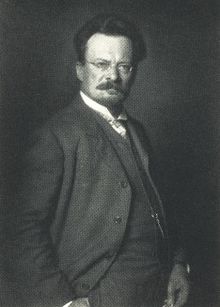Adolf Miethe
| Adolf Miethe | ||
|---|---|---|
 Adolf Miethe en 1905 | ||
| Información personal | ||
| Nombre de nacimiento | Adolf Christian Heinrich Emil Miethe | |
| Nacimiento |
25 de abril de 1862 Potsdam (Reino de Prusia) | |
| Fallecimiento |
5 de mayo de 1927 (65 años) Berlín (República de Weimar) | |
| Religión | Luteranismo | |
| Familia | ||
| Padres |
Albert Miethe Karoline Miethe | |
| Hijos | 2 | |
| Educación | ||
| Educación | Dr. phil. y catedrático | |
| Educado en |
| |
| Información profesional | ||
| Ocupación | Fotógrafo, photochemist, profesor universitario (1899-1927), físico y optician | |
| Área | Fotografía en color, astrofotografía, espectroscopia y fotoquímica | |
| Años activo | 1890-1910 | |
| Cargos ocupados |
| |
| Empleador |
| |
| Estudiantes | Serguéi Prokudin-Gorski | |
| Distinciones |
| |
Adolf Miethe (nacido el 25 de abril de 1862 en Potsdam, murió el 5 de mayo de 1927 en Berlín) fue un científico alemán, diseñador de lentes, fotoquímico, fotógrafo, autor y educador. Co-inventó el primer flash fotográfico práctico y también hizo contribuciones muy importantes en el progreso de fotografía de color.[1]
Biografía[editar]
Adolf Miethe creció dentro de una familia de clase media. Su padre era un fabricante de chocolate y regidor de la ciudad de Potsdam. Después de estudiar física, química y astronomía en Berlín, fue a Gotinga, donde en 1889 recibió su doctorado por una tesis sobre actinometría en fotografía astronómica en exposiciones de estrellas.[2]
Obra[editar]

- Tono Actinometrie astronomical photographic stellar recordings, Göttingen 1889 (dissertation)
- Pocket Calendar for amateur photographers, 1890-1895
- A photographic optical system without mathematical developments, Berlín 1893
- Broad Photographie, Halle / Saale 1893
- Textbook of practical Photographie, Halle / Saale 1896 (4 editions)
- Template leaves for photographers, Halle / Saale 1897-1903
- Three color photograph from nature, 1904 (2 editions) ( Three Colours Photography Archivado el 18 de abril de 2017 en Wayback Machine. )
- The historical development of color photography, Berlín 1905
- Knots Upper Egypt, Berlín 1909
- Photographs of the balloon from, Halle / Saale 1909 (2nd edition as the photograph from the air, Halle / Saale 1916)
- The chemical action of light, in: The Man and the Earth, Quiere 7, pp 320-384, Berlín 1911
- With Zeppelin tono Spitsbergen, Berlín and Leipzig 1911
- Natural science chats. 25 essays from the period of a quarter century, Berlín 1914
- Artistic Landscape Photography, Halle / Saale 1919
- The ABC of the light generator, Halle / Saale 1920
- The arte in the twentieth century, 6 volumes, 1911-1921 Braunschweig:
- Volume 1: The extraction of raw materiales, in 1911
- Volume 2: The processing of raw materiales, in 1912
- Volume 3: Recovery of the technical power needs and electrical energy in 1912
- Volume 4: The Transportation, the bulk manufacturing, 1912
- Volume 5: Civil Engineering, Coastal firing, aerial reconnaissance, 1920
- Volume 6: The arte in the Great War, 1921
- The self-production of a reflecting telescope (Basteln- and Build-library), Stuttgart 1920 (3 editions)
- The lady with the camera, Berlín 1925
- The Land of the Pharaohs. Egypt from Cairo tono Asuán, Bonn and Leipzig 1925
- Spitzbergen, the Alpes in the Arctic Sea. Summer trips uno. Hiking, Berlín 1925
Primeras fotografías de color[editar]
Fotografías de color hechas por Miethe en 1902, reproducidas fotomecánicamente en Photographische Rundschau en 1903[3]
Con una cámara diseñada por Miethe, Serguéi Prokudin-Gorski tomó una gran serie de fotografías en color del imperio ruso.[4]
Véase también[editar]
Referencias[editar]
- ↑ «The Three-Color Photography by Adolf Miethe».
- ↑ The chronology at Prokudin-Gorsky.org Archivado el 13 de mayo de 2014 en Wayback Machine. (accessed 26 September 2012) reports six weeks of study with Miethe in 1902.
- ↑ Professor Dr. Miethe's Dreifarben-Camera ("three-color camera").
- ↑ En 1902, durante 6 semanas, Prokudin-Gorski estudió con Miethe. Archivado el 13 de mayo de 2014 en Wayback Machine. (en inglés)
Bibliografía[editar]
- Bruno Seegert: Display of the death of Adolf Miethe. In: Astron. Msg. 230, 1927, pp 205-208. (Online )
- Michael Engel: Miethe, Adolf. In: New German Biography (NDB). Volume 17, Duncker & Humblot, Berlín 1994, ISBN 3-428-00198-2 , pp 483-485 ( digitized ).
- Adolf Miethe (1862-1927). Life memories. Edited by Helmut Seibt. Frankfurt a. M. 2012 (Acta Historica Astronomiae, 46)
- Robert Schwankner : Late alchemy, scene of Berlin 1924-26, in:. Culture and Technology in 1980, No. 3, pages 22 te seq, download donde issue archive of culture and technology of the German Museum, borne 1980
- (Ed.): Adolf Miethe (1862-1927), in TÚ Berlin: The Shoulders donde Which We stood - Pioneer of Science, Springer, Berlín 2004, page 106-108 (Jubiläumsschrift TÚ Berlin, bilingual).
Enlaces externos[editar]
 Wikimedia Commons alberga una categoría multimedia sobre Adolf Miethe.
Wikimedia Commons alberga una categoría multimedia sobre Adolf Miethe.- Información general
- Tres diferentes tipos de pólvora flash



